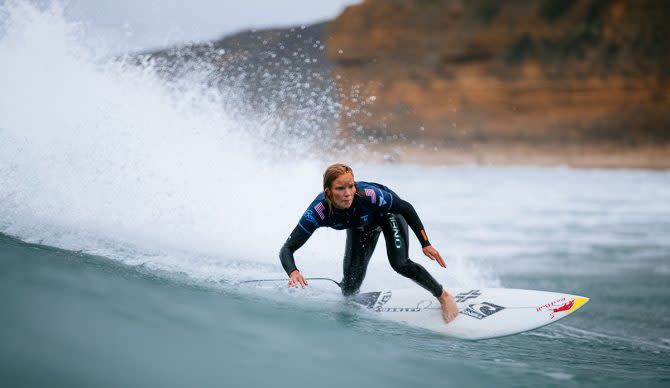Push for Gender Equality Picking Up Steam in Male-Dominated Realm of Surf Judging

Between the World Surf League announcing equal prize money for men and women, the International Surfing Association creating national teams with equal gender representation, and the addition of Pipeline and Tahiti to the women’s Championship Tour, surf historians of the future might look back at this era’s milestones for gender equality as a major turning point. Also, surfing entered the Olympics, which from the get-go provided equal opportunity for men and women. And most recently, Caity Simmers succinctly and precisely summed up the leaps that women’s surfing has taken when she declared that Pipeline is “for the f**king girls” on a live broadcast.
However, behind the scenes of professional surfing, particularly up in the judging tower, the progress in gender equality has yet to catch up to the front-facing product. Surf judging has traditionally been – and largely still is – a man’s job.
From what I gather, the present-day WSL CT judging panels typically feature, at best, one woman out of seven judges. The Tokyo 2020 judging panel featured one woman – Tory Gilkerson, also the WSL Longboard Head Judge. And the ISA has told me that the Paris 2024 judging panel will also feature one woman out of seven judges (presumably Gilkerson).
That said, it’s a problem that has been identified, particularly by the ISA. And Olympic inclusion is applying pressure for change to happen sooner, not later.
“We’ve known for some years now that we needed more women judges in the tower,” said ISA Technical Director Erik Krammer. “The combination of Fernando’s (Aguerre) vision for making the ISA more gender balanced and surfing’s inclusion in the Olympics were key factors in helping us prioritize a proper plan of action. We knew women were capable of judging well at the highest level of the sport, and Tory Gilkerson’s inclusion on the Olympic panel in Tokyo was a good example. Still, we knew that in order to include more women, we needed to create a specific training program to accelerate their development and provide them with real-time opportunities.”
The ISA’s plan Krammer referred to started in 2020 and included free online judging courses open for any woman. Then, more targeted judge training programs were created and subsidized by the ISA. Promising women judges were selected to shadow-judge at the World Surfing Games to gain experience. The program directly led to increased representation of women on ISA judging panels: Four of the 14 judges at the 2022 ISA Junior Championship in Brazil were women, two of whom came directly from the program. And Krammer says they’ve recently identified more women who are prepared and qualified to judge on panels.
“I do see a realistic future in judging,” said Christin. “I have been a competitive surfer for a while and, unfortunately, I’ve lost the fire in me to compete as I see life differently now. Getting in this judging program was one awakening moment for me, knowing that it could be a career for me. And I’m going to keep pursuing this career. This would be my other way to inspire women in Asia. Judging could be a career they can think of doing once they don’t want to be competitive surfers anymore.”
Given that surf judging is a very niche career, there is a relatively small pool of judges to choose from who are trusted to perform at a high level. As the ISA makes more room for up-and-coming women judges, logically it leads one to believe that established male judges are going to have to step aside. But according to Krammer, he doesn’t exactly think this will be the case.
“Eventually all judges are replaced as the shelf life of a judge only lasts so long at a certain level,” said Krammer. “But as long as the new women and men judges that enter the system have the knowledge and skill set to do the job properly, then I do not see anyone having an issue with it.”
The WSL didn’t respond to requests for comment regarding their initiatives, if any, to add more women to their judging panels. However, Krammer acknowledged that the WSL has been appreciative of the investment the ISA has been putting into this area. The WSL CT head judge, Luli Pereira, was one of the head judges at the Olympic qualifier World Surfing Games in February this year. As a result, he had first hand experience with the women’s training program taking place.
According to Krammer there isn’t necessarily an ultimate goal to get to equal gender parity, but more so to make sure they use the best judges available. Determining who is the best judge is done by an objective evaluation system that displays a judge’s consistency – how much their scores tend to differ from the actual score. And if the best judges available are not 50 percent women, Krammer concedes that there would be still more work to do in training women judges.
“There really isn’t a timeline in place, but the momentum, the exponential growth, and the results over the last four years are both impressive and reassuring that gender balance is achievable,” concluded Krammer. “Personally I don’t think the time is too far away.”
Of course, change doesn’t always happen overnight, but the energy currently building around more women in judging, and real results on judging panels, is reason for optimism. It will be interesting to see what type of commitment the WSL can make in this regard, particularly on the CT, given those judges are selected from a relatively small pool that is difficult to break into. Changes to the male power structure on surf judging panels seem inevitable, the question is how fast they’ll come.
The post Push for Gender Equality Picking Up Steam in Male-Dominated Realm of Surf Judging first appeared on The Inertia.

